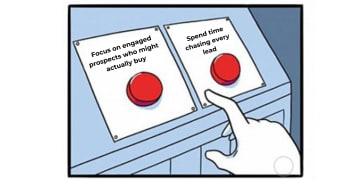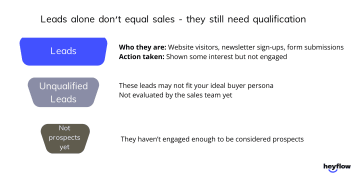Guides & best practices
View all articlesProspects vs leads: what’s the difference & how to convert them

Your sales team has a list of names. Some are prospective customers who might buy. Others are just... people. Figuring out who’s who? That’s the challenge.
Not all leads are worth chasing. Not all prospects are ready to buy. If your sales and marketing teams treat them the same way, you're leaving money and valuable customers on the table.

This guide breaks down and defines leads vs prospects. We explain how to identify leads and show you how to move them through the sales funnel. The goal? Get your team focused on the right sales opportunities – the ones that turn people into paying customers.
What is a lead?

A lead is anyone who has shown some interest in your company’s products or services. Maybe they signed up for a newsletter, downloaded an ebook, or filled out a form. They’re in your sales pipeline, but that doesn’t mean they’re ready to buy.
Leads exist in the initial stage of the sales funnel. They might fit your ideal customer profile, but they haven’t taken steps to show they’re serious about buying. Your sales and marketing teams need to qualify them – separating potential buyers from those who are just browsing.
At this stage, a lead might:
Visit your website
Download a lead generation magnet
Sign up for a free trial
Engage with marketing emails
Follow your brand on social media
But not all leads are prospects. Which brings us to….
What is a prospect?

A prospect is a lead that has moved past casual interest and shows real potential to become a paying customer. They’re actively considering your company’s offering, and they fit your ideal buyer persona based on factors like budget, authority, expressed interest, and need.
Prospects are more engaged and closer to closing sales than leads. They’ve taken steps that signal buying intent, such as:
Requesting a product demo
Responding to outreach from a sales rep
Asking specific questions about pricing or features
Showing a clear pain point that your product or service can solve
At this stage, your sales team focuses on nurturing leads into fully qualified prospects and sales opportunities. This means understanding their needs, addressing concerns, and guiding them toward a final purchasing decision.
What is the difference between prospect vs lead?
The key difference?
✅ Leads show interest
✅ Prospects engage and evaluate
Here’s a simple breakdown:
Lead | Prospect | |
Definition | Someone who has shown interest but hasn’t been assessed for sales potential | A lead that has been qualified as a serious potential buyer |
Stage in the sales funnel | Early-stage – top of the funnel | Mid-stage – moving toward a final decision |
Level of engagement | Passive – may have downloaded content or signed up for emails | Active – responds to sales reps, asks about pricing, requests a demo |
Qualification | Unverified – needs evaluation by sales or marketing | Meets criteria like budget, authority, and need |
Conversion potential | Low – many leads won’t progress | Higher – prospects have a real chance of buying |
Sales readiness | Not ready – needs nurturing | Ready for deeper conversations about solutions |
How to convert a lead into a prospect
So how do you know which leads are worth pursuing? And what steps move them from curious to committed? Let’s break it down.
Qualify the lead
Not all leads are worth pursuing. Some are just curious, while others have real potential to become paying customers. To separate the two, your sales team needs to run leads through a qualification process. This helps determine whether a lead is a good fit before investing time and resources.
The best way to qualify a lead? Use a lead qualification framework – a structured way to assess whether a lead is a prospect worth engaging with.
Here are the most effective lead qualification frameworks and when to use them:
Framework | Key criteria | Best for | Pros | Cons |
BANT | Budget, Authority, Need, Timeline | Short sales cycles, budget-driven deals | Simple, fast disqualification | Seller-focused; ignores deeper needs |
ANUM | Authority, Need, Urgency, Money | Avoiding gatekeepers, nurturing leads | Customer-centric; clarifies urgency | May miss gatekeeper connections |
MEDDIC | Metrics, Economic Buyer, Decision Criteria, Decision Process, Pain, Champion | Complex B2B/high-value deals | Reduces deal failure risk; data-driven | Time-intensive; requires deep analysis |
CHAMP | Challenges, Authority, Money, Priority | Problem-solving solutions | Builds trust via challenge focus | Longer sales cycles |
FAINT | Funding, Authority, Interest, Need, Timing | Impulse-driven/spontaneous buyers | Quick conversions; low effort | Requires high product enthusiasm |
GPCTBA/C&I | Goals, Plans, Challenges, Timeline, Budget, Authority, Consequences | Strategic B2B alignment | Holistic; ties solutions to long-term goals | Resource-heavy; not for quick decisions |
Score leads based on engagement
Lead scoring is a lead generation strategy that assigns points to leads based on their engagement level and fit with your ideal buyer persona. The more relevant actions they take, the higher their score. This helps sales teams prioritize qualified leads instead of wasting time on unresponsive ones.
Different businesses use different models based on what matters most to their sales process. Here are the main types:
Explicit lead scoring (Who they are) | Implicit lead scoring (What they do) | Negative lead scoring (Disqualifying factors) |
This scores leads based on their demographics, company details, and role. | This looks at how leads engage with your brand – the stronger the engagement, the higher the score. | Not all engagement is good engagement. Some leads should be scored down if they: |
✅ Job title and seniority → Decision-makers score higher. ✅ Company size → Does their business fit your ideal customer profile? | ✅ Website activity → Number of visits, time spent on pages, checking the pricing page. ✅ Email engagement → Opening emails, clicking links, or replying. ✅ Content downloads → Whitepapers, case studies, or gated resources. ✅ Demo requests and contact forms → A clear sign of sales intent. | ❌ Use personal email addresses instead of business emails. ❌ Repeatedly engage but never take real action (e.g., open every email but never click). ❌ Are outside your target market (wrong industry, location, or job role). |
Best for: Businesses that sell to specific industries or need to reach high-level decision-makers. | Best for: Companies where buyer intent is best measured by online engagement. | Best for: Companies that want to prevent low-quality leads from clogging up the sales pipeline. |
Lead scoring should be based on both engagement and qualification criteria. A well-structured system looks like this:
Website visits (+5) → Multiple visits signal higher interest.
Email opens & clicks (+10) → Engaged leads interact with content.
Demo requests or pricing inquiries (+25) → Strong buying intent.
Social media engagement (+5) → Following, liking, or commenting shows interest.
Downloadable content (ebooks, whitepapers) (+10) → They’re researching solutions.
Ignoring emails or unsubscribing (-10) → Signals low interest.
📌 So when is a lead ready? Set a threshold score for when a lead becomes a sales-qualified prospect. For example:
0–30 points: Cold lead → Needs more lead nurturing.
31–60 points: Warm lead → Engage with personalized content.
61+ points: Hot lead → Pass to the sales team for follow-up.
Identify buying signals
Unlike general lead scoring, which measures engagement levels, buying signals tell you when a lead is showing intent to purchase. Spotting these signals early helps marketing managers and sales reps focus on the right leads at the right time.
1. Buying conversations
They ask about pricing, contract terms, or ROI.
They request a proposal or quote.
They mention decision-makers or say, "I need to check with my boss."
They bring up competitors and want to compare features.
👉 What to do? These leads are evaluating options. Respond quickly, highlight your company’s offering, and address concerns before they choose another solution.
2. Decision-making steps
They request a product demo or free trial.
They ask detailed implementation questions (setup, onboarding, integrations).
They seek case studies or customer success stories to validate their decision.
👉 What to do? Help them visualize success with your product or service. Provide clear next steps, case studies, or testimonials that address their pain points.
3. Budget and timeline discussions
They ask about payment plans or contract flexibility.
They set a timeline for making a decision ("We want to finalize this next quarter.").
They discuss internal approval processes ("We need procurement to sign off.").
👉 What to do? These leads are moving toward a final purchasing decision. Guide them through the process and remove any roadblocks slowing them down.
📌 Do lead scoring and buying signal go hand-in-hand?
Yes, but they serve slightly different purposes:
Lead scoring identifies engaged leads (e.g., visiting pages, opening emails, attending webinars).
Buying signals highlight sales-ready prospects (e.g., asking about pricing, requesting a demo).
When both align, the lead is ready to be handed off to the sales team.
📌 So how should you act on buying signals?
Leads with high scores + strong buying signals → Pass to sales immediately.
Leads with buying signals but low scores → Follow up – engagement might not be tracked properly.
Leads with high scores but weak signals → Keep nurturing – engaged doesn’t always mean ready to buy.
What is the importance of lead nurturing
Lead nurturing = Better sales opportunities
Not all leads are ready to buy immediately. Many need time to evaluate options and build trust before they make a decision. Lead nurturing ensures they don’t slip away by keeping them engaged with relevant content and interactions.
Here’s why lead nurturing is a critical part of the sales process:
✅ Keeps leads engaged until they’re ready to buy: Interest doesn’t always mean intent. Many leads are exploring options, comparing solutions, or waiting for budget approval. If you don’t stay in touch, they’ll move on. Lead nurturing keeps your brand top-of-mind, so when the right moment comes, they think of you – not your competitor.
✅ Builds trust and credibility: People don’t buy from companies they don’t trust. If a lead isn’t sure your product or service can solve their problem, they won’t commit. Lead nurturing educates them over time, providing case studies, testimonials, and industry insights that position your brand as the right solution. When they’re finally ready to purchase, they’ll feel confident choosing you.
✅ Helps qualify leads effectively: Not all leads are created equal. Some will never convert, while others just need more time. Lead nurturing acts as a filter, helping your sales team separate high-potential leads from those who aren’t the right fit. By tracking engagement – who opens emails, clicks links, or downloads content – you can focus on leads and prospects who actually show interest and intent.
✅ Shortens the sales cycle: A nurtured sales lead enters the sales funnel already familiar with your solution. They know how it works, what problems it solves, and why it’s valuable. This means fewer objections, faster decision-making, and less back-and-forth during the sales process. Instead of starting from scratch, your sales reps can move straight to addressing specific concerns and closing the deal.
✅ Prevents leads from going cold: A lead that goes silent isn’t always a lost sales opportunity – it could just be bad timing. Maybe they weren’t the decision-maker, their budget wasn’t set, or they had other priorities. Without lead nurturing, these leads vanish. With it, you can keep them engaged through personalized follow-ups and valuable content until they’re ready to revisit the conversation.
✅ Aligns sales and marketing efforts: Marketing generates leads, but sales can’t act on them until they’re ready. Without lead nurturing, there’s a disconnect – marketing hands off leads too early, and sales wastes time chasing unqualified sales prospects. A strong lead nurturing strategy ensures leads stay engaged until they’re ready for sales, improving efficiency for both teams.
Sales strategies for converting prospects into customers
Here are the best sales strategies to move prospects through the final purchasing decision and secure the sale.
Personalize every sales interaction: A sales rep who tailors conversations based on their pain points, industry, and past interactions creates stronger engagement. Instead of focusing on product features, focus on how your product or service solves their specific problems.
Example: Rather than saying, “Our software helps businesses grow,” say, “Since you run an e-commerce store, our platform can reduce cart abandonment by 30% and increase conversions.”
Sell outcomes, not just features or price: Instead of listing features, highlight how your solution improves their business, saves time, or boosts revenue. If price is their biggest hesitation, show the ROI (return on investment) instead of justifying costs.
Example: Instead of saying, “Our service costs $500 per month,” say, “Our clients see a 3x return within 90 days, making this a profitable investment.”
Create a sense of urgency without pressure: Prospects delay decisions when there’s no immediate reason to act. However, pushing too hard can backfire.
Example: Instead of saying, “Sign up today before it’s too late!” say, “We have a pricing adjustment next month – locking in now secures the current rate.”
Follow up with value, not just reminders: A lack of follow-ups kills deals. But following up just to "check in" doesn’t move the conversation forward. Instead, use follow-ups to add value – share insights, answer objections, or provide relevant content.
Example: Instead of “Just checking in—are you ready to buy?” say, “I found a case study that addresses your team’s concerns—want me to send it over?”
Ready to convert prospects into customers?
With the right sales strategies, you can build trust, address objections, and create a frictionless buying experience. But doing this manually is inefficient. That’s why you need the right lead generation software.
As a no-code platform, Heyflow helps sales and marketing teams build high-converting lead funnels without needing developers. It simplifies every stage of the process:
✅ Capture high-intent leads with interactive landing pages and multi-step forms.
✅ Qualify and segment prospects automatically using smart workflows.
✅ Personalize engagement with dynamic lead paths based on responses.
✅ Eliminate friction with easy scheduling, CRM integrations, and automated follow-ups.
✅ Optimize conversions with A/B testing, analytics, and real-time insights.
With Heyflow, you guide leads through the sales funnel, so your sales team gets only the most qualified prospects ready to buy.
-------------
Create interactive B2B lead generation campaigns in minutes!
With Heyflow’s no-code platform, you can design interactive forms and landing pages that turn visitors into leads in minutes. No developers needed.


